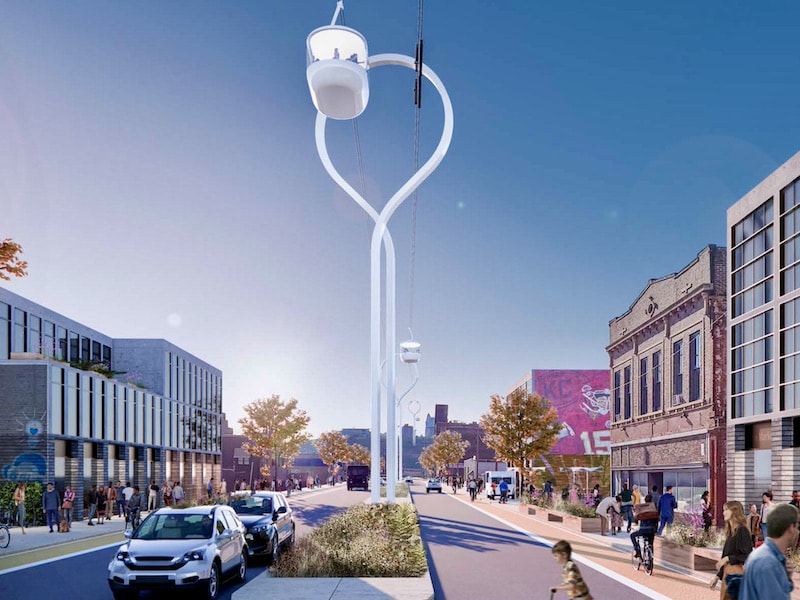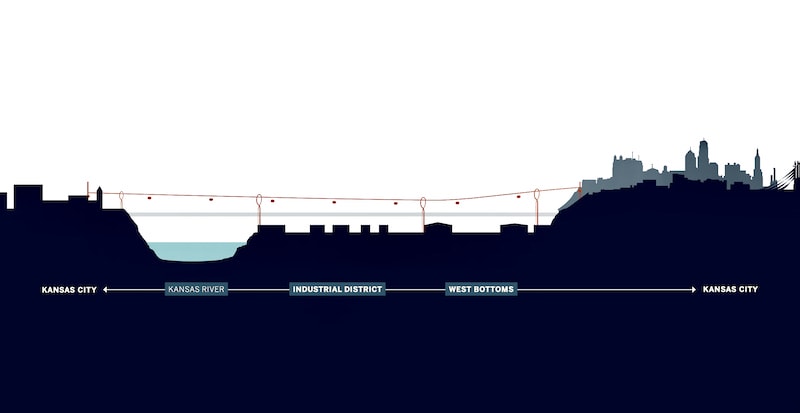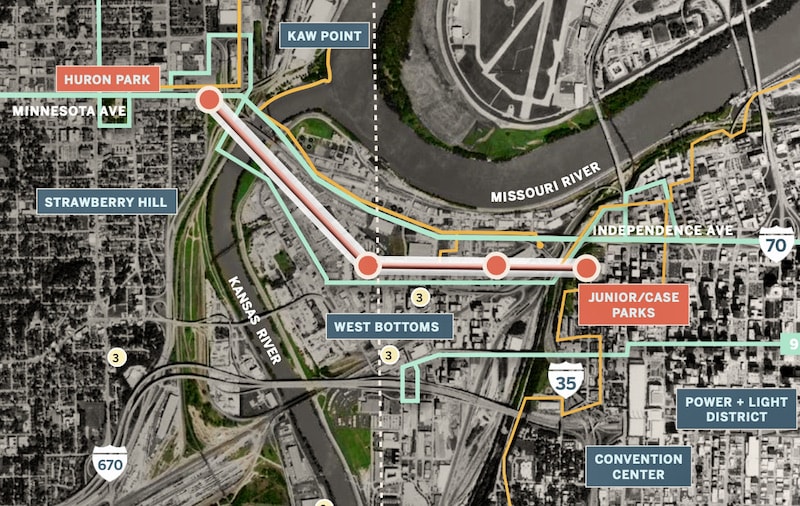Gondola Linking Downtowns KCK and KCMO Pitched by UG Official

Published November 12th, 2021 at 12:30 PM
By Kevin Collison
The idea of using gondolas for mass transit in Kansas City is back, but this time it’s being floated by a senior government official in Wyandotte County, not perennial petitioner Clay Chastain.
The concept calls for a two-mile gondola line above the West Bottoms that would link the downtowns of the two Kansas Cities, and it’s being pitched by Gunnar Hand, director of planning and urban design for the Unified Government of Wyandotte County/KCK.
“The idea is to connect the cities’ two largest pedestrian neighborhoods, their downtowns,” Hand said. “The benefit is it would be going from bluff to bluff over a serious geographic challenge and crossing the river.”
The UG commissioned national firms Skidmore Owings & Merrill (SOM) and HR&A Advisors to prepare a preliminary concept as part of a mobility strategy study, and Hand has been quietly soliciting comments about the idea for about a year.
Prior to coming to the UG, Hand was an associate at SOM for five years, according to his Linkedin profile.

Cross section of how a gondola or aerial lift line could run from near Strawberry Hill to Quality Hill. (Image from SOM/HR&A study)
He said the UG wants the Mid-America Regional Council to include the gondola concept in its long-range transportation plan. That would then open the door to potential further funding.
“If adopted by MARC, we’ll be seeking money for a feasibility study,” Hand said. “We’d like to be collaborative with Kansas City, MO.”
Hand said a gondola line, or what’s generically described as an “aerial lift,” could run between Case Park/Quality Hill on the Missouri side to St. John’s Park/Strawberry Hill in KCK. It could include two stops serving the West Bottoms as well.
An aerial lift could cost about half as much per mile to build than the Kansas City streetcar, $25 million vs $50 million, Gunnar said. Gondola cabins range in size from 15 passengers to 35-40 passengers, and a line could carry between 3,000 and 5,000 people per hour.
The gondola project envisioned by Hand differs significantly from the concepts pitched by Chastain in his petition drives. The Chastain proposals focused on a line from within downtown Kansas City to Penn Valley Park, and much smaller passenger cabins.

Portland, OR already has an urban gondola line in operation. (Photo from SOM/HR&A study)
The study prepared by SOM suggested a gondola line between the two downtowns could benefit downtown KCMO by linking it with the more affordable housing in Strawberry Hill and reinforce the economic development of both communities.
“An aerial lift will bring both the West Bottoms and downtown KCK within walking distance of downtown KCMO and its wealth of cultural attractions, convention center activity, arena events and jobs,” the study reported.
“The lift has the potential to not only be a functional commuter model, but a destination in and of itself…
“And with arguably the best view of the KC skyline and significantly lower housing costs, downtown KCK can leverage the success of downtown KCMO redevelopment into its own continual renaissance.”
Hand said successful urban gondola lines already exist in cities that include Portland, OR, New York City and Medillin, Colombia.

A potential gondola route from Strawberry Hill to Quality Hill with two West Bottoms stops. (Map from SOM/HR&A study)
The SOM report suggested that an aerial lift line could be less expensive to operate than other forms of transportation, observing the systems are designed to last up to 30 years “comparable or superior to rail cars and buses.”
“The system could potentially offset both operational and capital costs with sponsorships, special packages and events, naming rights, or real estate related revenues from integrated to adjacent development,” the report stated.
The aerial lift line could be managed by the Kansas City Area Transportation Authority, a private entity or a public-private partnership, according to the study.
Hand also said the gondola could repair what was once a robust transit connection between the downtowns. At one point in their history, the two Kansas Cities were knit together by two streetcar lines and several bus routes.
“Those connections have deteriorated and basically we now have the viaduct and that’s it,” he said.
A potential gondola line is the latest example of the Unified Government’s stepped up interest in the West Bottoms. The UG also is planning a park, bike trail and other improvements along the Kaw River.
As part of his ongoing educational campaign, Hand is scheduled to make a presentation on the gondola concept at the Kansas City Downtowners luncheon on Dec. 8.


